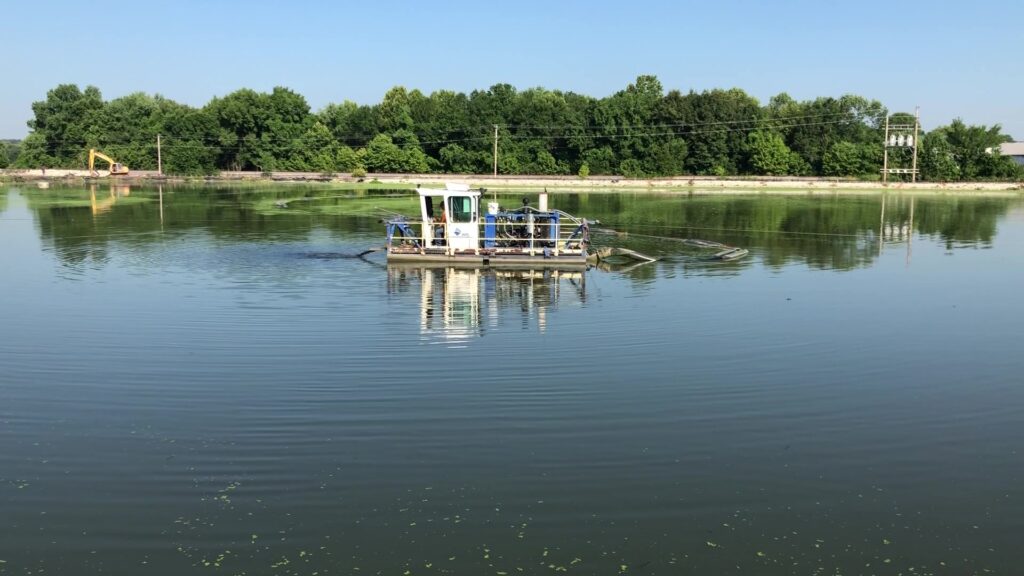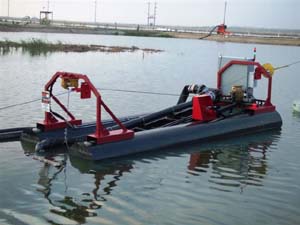Many wastewater lagoons suffer from excess lagoon sludge accumulation. That being the case, wastewater lagoon sludge treatment is a common challenge for wastewater lagoons worldwide. Excess lagoon sludge can lead to higher effluent levels of BOD, TSS and ammonia along with some terrible lagoon odors. For an example of what happens when sludge is allowed to accumulate too much, see our blog: Wastewater Lagoon Mixing Alleviates Odor & Sludge Issues.
This article, the second in a two-part series, focuses on the causes and subsequent effects on your wastewater lagoon when sludge starts to build up. Our first article, Causes & Effects of Wastewater Lagoon Sludge Explained, considered why sludge accumulates in your lagoon in the first place.

Lagoon Sludge Removal:
Lagoon dredging is by far the most common form of lagoon sludge removal. There are a few different methods of lagoon dredging, all of which involve mechanically removing sludge from the lagoon. Once the sludge is removed, it is dried and is transported to either a landfill or a land application facility. This is an extremely laborious and costly process. An average cost is around $350 per dry ton of sludge. Many lagoons can easily have as much as 2500–5000 dry tons of sludge stored up (i.e. $875,000–$1,750,000). For this reason this approach is often the last resort of wastewater lagoon operators.
In some cases, especially when a lagoon has been overrun with sludge, mechanically removing sludge is the only option. However, there are some sludge treatment options that we elucidate on below.
Wastewater Lagoon Sludge Treatment:
- Proper Aeration and Mixing—For most lagoon operators, the best step towards wastewater lagoon sludge treatment is ensuring that your aeration system is fully functional. First, you should assure that your system provides ample oxygen to as much of the lagoon as possible. Second, you should implement a system that creates a thorough, turbulent mixing of the water column. These two factors will ensure that sludge won’t continue to accumulate, and will also help treat the sludge that may have already built up in the lagoon. Without mixing and aerating the entire water column, sludge will accumulate on the bottom of the wastewater lagoon and break down anaerobically. This is a very slow process that will only lead to more sludge buildup over the long term. If you can provide the sludge with oxygen, natural bacteria will break it down aerobically, which is faster and occurs without odorous byproducts. Our article, Lagoon Aeration: Enemy of Sludge Accumulation, gives more detail about the sources of sludge and how proper aeration keeps sludge in check.
Different types of lagoon aeration will be able to mix and aerate better than others. See our article, Lagoon Aeration Alternatives: An Overview, for more information about the relative mixing effectiveness of different lagoon aeration technologies.
- Bioaugmentation—In addition to proper aeration, some wastewater lagoon operators have successfully augmented their lagoon with specially formulated blends of bacteria. These bacteria essentially act as a boost to the natural bacteria that already exist within the lagoon. Working in conjunction with proper aeration and mixing, independent studies have shown that this method of wastewater lagoon sludge treatment can help to break down the lagoon sludge aerobically over time.
The options for wastewater lagoon sludge treatment or removal aren’t plentiful. The best way to guard against problematic effects from sludge accumulation is to assure that you have an aeration system that will properly address the issue. This must be done with effective aeration and thorough mixing of the entire wastewater lagoon. The question of whether to treat or remove lagoon sludge is one that comes down to how much sludge has actually accumulated. Check out our article on How to Perform a Lagoon Sludge Survey for this topic in detail. If excess sludge is allowed to accumulate to the point where you are breaking your permitted effluent requirement, then dredging is likely your only option. However, if you still have time, then wastewater lagoon sludge treatment has been shown to be possible and much more cost effective.
Download our Ares Aeration® literature for more information on how you can retrofit your lagoon in order to improve aeration and mixing and begin treating sludge.

